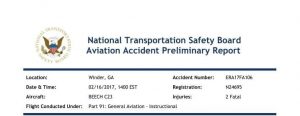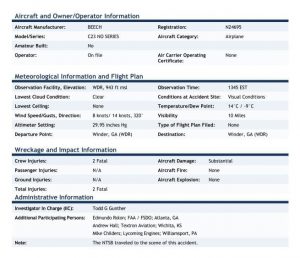The National Transportation Safety Board has released a preliminary report on the plane crash that killed two in Barrow County last month. Read the full preliminary report here:
On February 16, 2017, about 1400 eastern standard time, a Beech C23, N24695, was
substantially damaged when it impacted trees and terrain after takeoff from Barrow County
Airport (WDR), Winder, Georgia. The flight instructor and student pilot were fatally injured.
Visual meteorological conditions prevailed, and no flight plan was filed for the local
instructional flight, conducted under the provisions of Title 14 Code of Federal Regulations
Part 91.
No one witnessed the airplane takeoff. Review of security camera video indicated that prior to
the accident flight, the flight instructor and student pilot walked out to the airplane about 1317.
About 1357, a pilot who was inbound to WDR while approximately 5 miles north of the airport,
heard a pilot transmit that they were departing Runway 31. The pilot looked for the departing
airplane but never saw it. He then landed on Runway 31, and taxied to the ramp.
At approximately 1400, a witness observed the airplane pass from left to right in front of her,
as she was traveling on Highway 82. At the time, she was passing the northwest corner of
WDR. The airplane seemed to be flying low and fast, and as it went over the highway it began
to nose down, then leveled out, and “tilt to the right about 1/4 or less.” The witness then lost
sight of the airplane due to trees. She then thought she saw “a small puff of gray to the outside
edge of the tree line” when she looked back. She later realized that this may have been the trees
moving as the airplane struck them. Also,, just past the trees to the inside of the tree line, she
thought she saw a runway but later realized that it was an access road to the airport. She did
not hear any sounds associated with the airplane, as she had her radio on in the vehicle.
The accident site was located on the southwest side of Runway 31, next to the airport security
fence, along a tree line next to an open field. Examination of the accident site revealed that the
airplane struck trees while traveling on an approximate magnetic heading of 146°, and had
broken into several pieces. Evidence of propeller strike marks were observed on several trees,
along with cut and separated branches.
Examination of the wreckage revealed that the wing flaps were in the up position. The
magnetos switch was in the “BOTH” position. The electric fuel boost pump was off. The fuel
selector valve was in the “R TANK” position, and there was no evidence of blockage in the valve or fuel lines. The throttle and mixture controls were full forward, and the carburetor heat knob
was in the off position. Control continuity was established from the ailerons, stabilator, and
rudder, to the breaks in the system, and from the breaks in the system, to the flight controls in
the cockpit. There was no evidence of any inflight structural failure.
Examination of the propeller and engine revealed that the propeller displayed evidence of S-
bending, and chordwise scratching. There was no evidence of any type of blockage in the
engine intake or exhaust systems. There was oil in the galleries and rocker boxes. Drivetrain
continuity was established from the propeller to the back of the engine, thumb compression
and suction was established on all four cylinders, and all the intake and exhaust valves
functioned. Both magnetos produced spark on all towers, and the spark plug electrodes
appeared normal. Fuel was present in the fuel line to the carburetor and fuel was present in the
carburetor float bowl.
At 1345, the reported weather at WDR, included wind from 320° at 8 knots, gusting to 14
knots, temperature 14° C, dew point -09° C, and an altimeter setting of 29.95 inches of
mercury.
According to Federal Aviation Administration (FAA) and pilot records, the flight instructor
held an airline transport pilot certificate with a rating for airplane multiengine land, and
commercial privileges for airplane single-engine land. He also held a flight instructor
certificate with a rating for airplane single engine land. His most recent FAA first-class medical
certificate was issued on September 12, 2016. He reported that he had accrued 1,650 total
hours of flight experience, 1,452 hours as pilot-in-command, 518 of which was as a flight
instructor.
According to FAA and pilot records, the student pilot held a student pilot certificate. His most
recent FAA third-class medical certificate was issued on January 30, 2017. He had accrued
approximately 8 hours of flight experience.
According to FAA and maintenance records, the airplane was manufactured in 1973. Its most
recent annual inspection was completed on October 3, 2016. At the time of the accident, the
airplane had accrued 2,680 total hours of operation.
The wreckage was retained by the NTSB for further examination.
Follow @GradyNewsource on Facebook and Twitter for breaking news and top stories.









